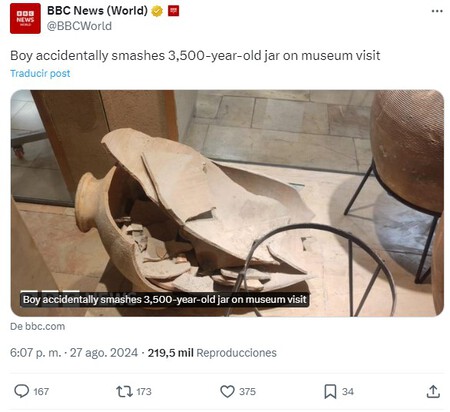He Hecht Museumin Haifa, Israel, has just reminded us in a tremendously graphic way that 3,500 years of history They can shatter in an instant and with a simple touch. Literally. That is what recently happened to one of the Bronze Age vessels on display in its halls, a valuable piece for archaeologists both for its age and for its exceptional state of preservation, which has become a ceramic puzzle.
The person responsible: a child whom the museum already has encouraged to return.
“It wasn’t my son”. Exactly that is it what he thought Alex recently when, during a visit to the Hecht Museumin the northern Israeli city of Haifa, saw her four-year-old son lying next to an ancient pot that had been smashed to pieces. “It wasn’t my son who did this.” The problem was that she was mistaken.
His son had just knocked over a Bronze Age vase, no less. And with such bad luck that the piece, after breaking off its metal support, had ended up in pieces on the floor. It was no longer a vase. It was a 3,500-year-old puzzle.
Was it that serious? If we base it on the piece, yes. Quite a bit. The defenestrated vessel was a piece of at least 3,500 yearsaccording to estimates by archaeologists, who date it between 2200 and 1500 BC. Experts believe that it predates the reigns of David and Solomonin the 10th century BC, and was once used to store and transport valuable liquids such as wine or olive oil.
Old and well preserved. Besides its age, the vase was remarkable for another reason: how well it had been preserved. Unlike other ceramic pieces that archaeologists find already deteriorated, the Haifa vessel survived the passage of millennia surprisingly well. And it is not small.
“Similar vessels have been found in archaeological excavations, but most were broken or incomplete,” explains Inbal Rivlin, director of the Israeli museum, in a statement picked up by the newspaper The New York Times“The vase on display at the Hecht Museum, however, was intact, and its size made it an impressive discovery, located at the entrance to the museum.”

A sum of factors. The fact that the piece now lies in pieces in a restorer’s workshop is explained by a number of factors. One of them is the boy’s curiosity, who, his father explains, “took a little pull” on the vase to see what was inside. The other is the museum’s philosophy and how it presents its exhibits.
As those responsible for the center have been stressing over the last few days in the BBC, or the Israeli website Ynetthe institution considers that the pieces should be within reach of visitors whenever possible. And in the case of the Bronze Age ceramic jar, it considered that this was the case. It was displayed without showcasenear the entrance to the compound… and within reach of Alex’s son.
Feeling the archaeologyThe museum argues that there are “a special charm” where visitors can “experience the archaeological find without obstacles.” “Whenever possible, items are displayed without barriers or glass,” recognizes the BBC The institution, founded in 1984 by Reuben Hecht, houses ancient pieces dating back to the Bronze Age in its halls at the University of Haifa.
The ill-fated vessel I was 35 years old at the museum, which describes what happened as a “freak incident.” It therefore seems unwilling to change its approach, inspired by its founder. “The museum is not a mausoleum, but a living place, open to families and accessible,” The director emphasizes To Ynet: “We appeal to parents. Do not be afraid. Things like this happen. We will fix it.”
Solution: restorer and posters. Although the father of the little boy recognized the BBC “He was shocked” by what happened, but it seems that the incident will not have any major consequences for him or his son. “There are cases where exhibits are damaged on purpose and these cases are dealt with severely, even involving the police,” explain from the museum. “In this case, that was not the case. The vessel was accidentally damaged by a child and the response will be appropriate.”
The institution has already chosen a specialist who will be in charge of restoring the vase so that it can return “shortly” to the museum’s galleries, an expectation that the child’s parents see as “relieved.” What is certain is that Rivlin advances is that it will take advantage of what happened to educate the public: new signs will be installed to inform visitors which objects can be touched and which cannot and the center has insisted on the need for families “prepare the children” before visiting a museum.
Those responsible for the venue also have encouraged the child and his parents to return to the center to see the vessel once it is restored.
A not so rare case. It is not the first time that a stumble has given a visitor a scare… and damaged a work of art or an antique exhibit in a museum. In 2016, two children also suffered the same They damaged a sculpture at the Shanghai Virio Museum, in the Hirshhorn Museum from Washington a visitor also crashed by accident part of the exhibition in 2017 and in 2010 a woman lost her balance at the Metropolitan Art and ended up falling on Picasso’s painting ‘The Actor’.
Images | Wikimedia and Krakenimages (Unsplash)
At Xataka | This fountain has no water. It has mercury and is so toxic that it can only be seen through glass














Add Comment